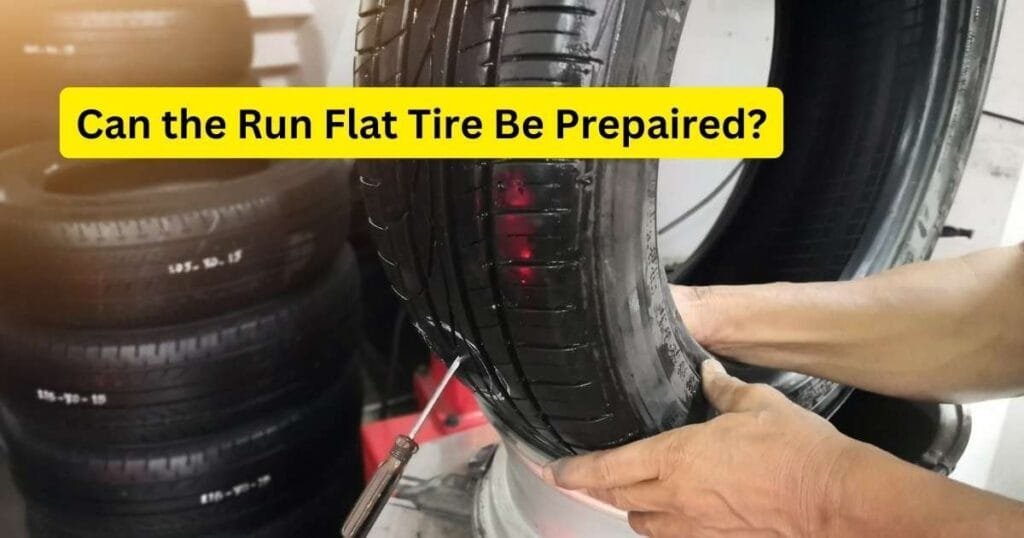Flat tires can be frustrating, often requiring swift repair or replacement to resume safe driving when it comes to run-flat tires.
The repair process differs significantly from conventional tires due to their reinforced sidewalls, which are designed to support the vehicle even after air loss.
Manufacturers generally advise against repairing run-flats due to challenges in assessing internal damage caused by punctures. Despite this, certain conditions may permit repairs under thorough inspection by a qualified tire professional.
Safety remains paramount, as some damages may necessitate tire replacement to ensure continued safe operation. Understanding these factors empowers informed decisions when faced with the inconvenience of a flat, run-flat tire.
Table of Contents
Can the Run-Flat Tire Be Repaired?
Repairing a run-flat tire after a puncture is more complex than fixing a regular tire. Manufacturers often discourage repairing run-flats due to their reinforced sidewalls.
They are making it challenging to assess internal damage from punctures. However, some manufacturers permit repairs under specific conditions.
However, a qualified tire professional must inspect the tire to determine its repairability. Factors such as how far you drove on the flat tire, how much air it lost, and its condition also influence repairability.
In such cases, it’s crucial to consult a tire professional. They can examine the tire and advise on whether it can be repaired according to the manufacturer’s guidelines and the tire’s condition.
But safety should always be the top priority. If there’s any doubt about the tire’s safety, it’s best to focus on replacing it. Run-flat tires are designed for temporary use after a puncture, so replacing the tire ensures continued safe driving.
When is Repair a Possibility?
Several key factors come into play when considering whether a flat tire can be repaired. The location of the puncture is crucial, especially punctures in the tread area.
The central and grooved sections of the tire are the most likely candidates for repair. This is because the tread is the tire’s thickest and most robust part. They are providing ample space for a patch to create a secure seal.
Another critical factor is the size of the puncture. Small punctures, less than 6 millimeters (¼ inch) in diameter, are generally considered repairable.
But more considerable punctures compromise. The structural integrity of the tire poses a safety risk when patched.
Additionally, the severity of the damage influences repairability. Clean punctures caused by nails or screws are often suitable for repair.
In contrast, irregular tears, gouges, or sidewall damage are not repairable due to their impact on tire stability.
The age and condition of the tire play a significant role in determining whether it can be patched. Older tires with excessive wear and tear may not be suitable for patching.
Due to weakened structural integrity. Thus, assessing these factors is essential when determining the possibility of repairing a flat tire.
What is the repair process for run-flat tires?
The repair process involves following the steps of a professional tire. If your tire is deemed repairable, the technician follows these steps.
The affected tire is removed from the rim to allow access to the inner liner and inspect the damage.
Next, the technician examines the tire’s internal and external surfaces, searching for hidden damage or previous repairs.
The puncture area is then cleaned and prepared for patching to ensure a proper seal.
A specialized plug-and-patch combination is applied to seal the puncture. The plug fills the hole from the inside, while the patch reinforces it from the outside, creating a strong and airtight seal to prevent air leakage.
Once the patch has cured, the tire is rebalanced to ensure even weight distribution and prevent vibrations during driving.
The repaired tire is reinstalled on the rim and inflated to the recommended pressure, completing the repair process.

When does replacement become necessary: Safety first?
When considering tire repair, safety should always be the top priority. While fixing a flat tire may seem like a cost-saving option.
Certain circumstances call for tire replacement to ensure safety on the road. Some indicators that replacement is necessary include punctures exceeding 6 millimeters (¼ inch) in diameter.
This is especially true if there are many punctures close together, such as damage to the sidewall, which is crucial for tire stability and warrants replacement.
Tires with significant wear and tear that compromise their integrity should be replaced. It’s essential to be mindful of the tire’s lifespan.
As tires nearing the end of their life, they may no longer provide adequate safety on the road.
Suppose there’s uncertainty about the repairability of a tire. It’s best to err on caution and seek advice from a qualified tire professional.
They have the expertise to assess the damage and recommend the safest action. It’s repairing the tire or opting for replacement.
What are the Additional Considerations?
When contemplating tire repair. There are extra factors to consider beyond the repair itself. One crucial aspect is the cost associated with professional repair.
While generally cheaper than replacing a tire, it still incurs expenses. It’s essential to weigh the repair cost against the tire’s remaining tread life before deciding.
Moreover, it’s essential to consider the time commitment required for the repair process. , repairing a tire takes approximately 30-45 minutes per tire.
It’s important to factor in this time commitment when deciding between repair and replacement, especially if you’re on a tight schedule.
Convenience is another factor to consider. Not all repair shops operate 24/7, and finding one during off-hours might be challenging.
In such cases, having a spare tire and a roadside assistance plan can be a backup for unexpected situations. Ensuring you’re prepared for any tire-related emergencies that may arise.
Conclusion
A flat tire can be frustrating, but it doesn’t have to derail your journey. By understanding the factors influencing repair feasibility, the repair process itself, and the situations where replacement is necessary, you can make an informed and safe decision to return to the road immediately.
Remember, prioritizing safety should always be your top concern. When in doubt, seek professional guidance from a qualified tire technician.
FAQs
Can I repair a flat tire myself?
While some minor punctures can be patched or plugged at home with a tire repair kit, it’s essential to consider your level of expertise and safety precautions. For more severe damage or if you’re unsure, it’s best to consult a professional.
How long does it take to repair a flat tire?
The time required to repair a flat tire can vary depending on factors such as the extent of the damage and the repair method used. Generally, a professional repair takes 30-45 minutes per tire.
Is it safe to drive on a repaired tire?
When a tire is repaired following the manufacturer’s guidelines, it can be safe to drive on. However, it’s crucial to check the repaired tire for any signs of damage or loss of air pressure.


